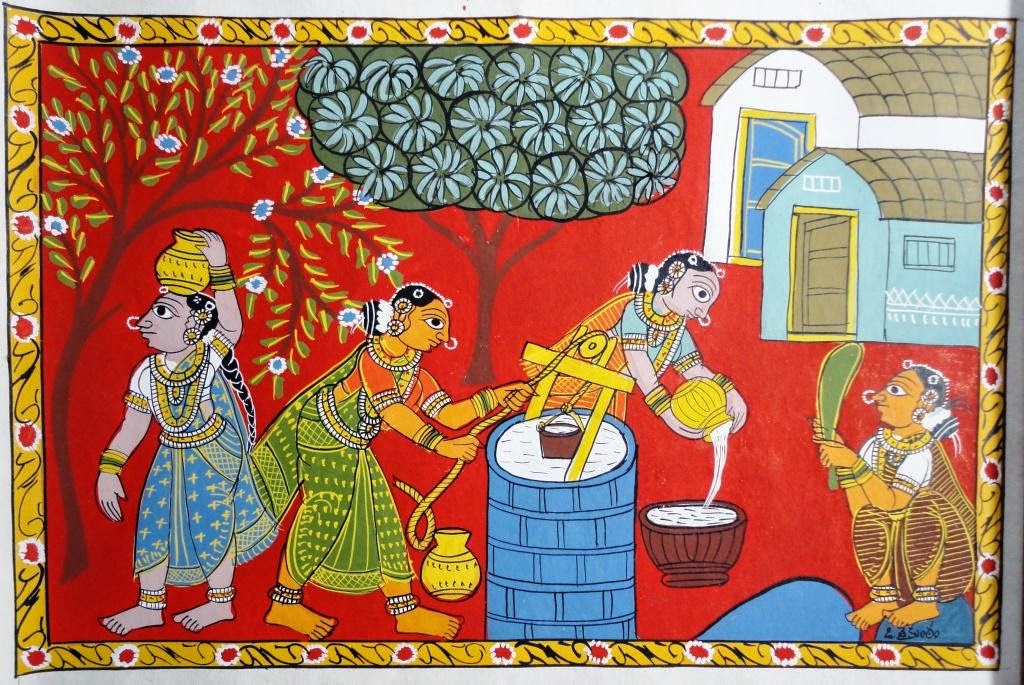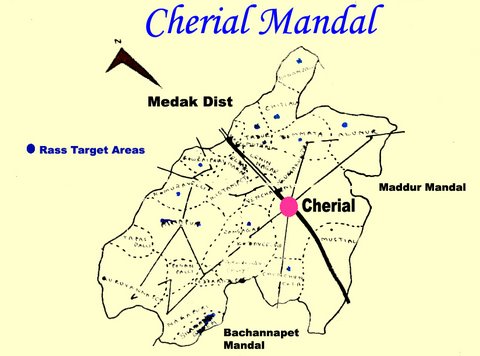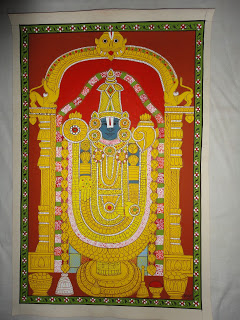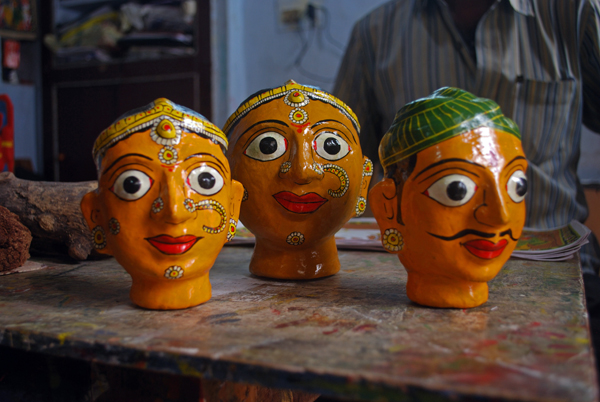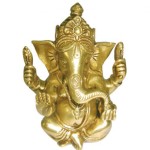From the world of High Culture and refined Dance, we move on to the land of popular and provincial culture. Along with the Marga, we celebrate the Desi (pun intended)to connect with our roots.
Continuing our Series on Arts & Crafts , is the native ancient style of scroll painting in young Telangana State: Cheriyala.
History
Originating in and concentrated around the village of Cheriyala in Warangal District, this craft grew in the heart of modern Telangana state. The rural agglomeration is located 93 kms outside the main city of the District, and is accessible by road or train.
At present, the dating for the technique and style is uncertain. What is known is that it is at least 500 years old (but very possibly much older). In fact…
Scroll painting is one of the ancient expressions in Telangana and dates back to Kakatiya dynasty. The genre of this painting displays the traces of the Kakatiya style of painting, seen in the 12th century wall paintings of Pillalamarri temple and hill temple of Tripurantakam. [8]
In the Pratapa Charitram, Ekamranatha notes that there were 1500 painters around Warangal.
Of late, appropriation of the traditional arts and culture of the region is being conducted by those who seem to think all things of value came from foreigners, including Cheriyala. That is the importance of this genre of painting being associated with the Kakatiyas whose rule began almost 1000 years ago (ante-dating the estimate of 500 years).
Techniques and styles and even methods may actually descend from the ancient Indic style of Pattachitra, which is still practiced in Odisha today, and was renamed as Kalamkari in the Telugu states, during the medieval period. The names may be new: Mahboobabad for Palamooru, Nizamabad for Induru, Bhongir for Bhuvanagiri, and Kalamkari for Pattachitra, but the origins are native, as was the original fort of Gollakonda. Like Madhubhani of Bihar, and the popular art of Rajasthan, Tamil Nadu and Sri Lanka, these styles represent the desi (provincial) traditions and approaches to art that date back millennia.
Historically, these painted scrolls of Cheriyala were shown to audience members while ministrels sung the genealogies of 7 local communities/castes. These were as follows: “Jaamba puraanam is performed for Maadigas by Dakkali sub caste; the Bhaavanaa Rishi and Markandeeya puraanam is performed for Padmasaalis by Kuunapuli sub caste; the madeel puraanam is shown for chakalivaallu by patamvaaru sub caste; the Gauda puraanam is performed for Gauds by Gaudajetti caste; Paandavula Katha is performed for Mudiraajs by Kaakipadagala sub caste; Addam puranam is for Mangalivaallu by addam varu; Kaatama Raju Katha is performed for Gollavallu by Mandechchuloollu. Instead of scrolls, performers in this Kaatamaraju performance use 53 dolls made by Nakashi artists“. [8]
As such, scenes from the Puranas are commonly ceremonialised in this rustic style of popular artwork. Similar, vibrantly coloured paintings can be found in Telangana’s interior (i.e. countryside Temples) even today.
Cherial paintings or scroll paintings are used by a community known as ‘kaki padagollu’ that uses this medium as a visual aid to narrate stories from Ramayana and Mahabharata. [9]
Characteristics

There are in fact two crafts associated with Cheriyala. The first is the more famous scroll paintings. The second are wooden dolls and masks.
Despite being scroll paintings made of traditional materials, each one is said to last for over 150 years.
The main attraction of cheriyala scroll paintings is that it is made from all natural materials, and therefore, good for the environment (as well as the heritage workers depending on the craft). The colours are very striking, and are made from water-based and earth-based ingredients.
The powder of a stone called ‘inglikum’ elevates the background in bright red colour, pevudi yellow shades, unique ‘zink white’ is used to depict pearl like ornamentations and the thick Indigo blue colours are used across the paintings making these picturesque frames theatrical representations of life. [8]
Due to the speed at which they can be created, the Cheriyala Scroll painting is a traditional Storyteller’s dream, and is used for that purpose.
Process
The canvas is made from khadi cloth. On this, coating consisting of “a mixture of tamarind seed powder, white clay, and rice starch is applied thrice to make it stiff“. [4]
After the first coating dries, a second one is added. Gum water is also used.
Brushes made from squirrel hair are used to paint the subject proper. This results in very precise outlining that enhances the vibrancy and redolence of the artwork.
As for the wooden articles, the bommas (dolls) and masks are made from sawdust, tamarind and timber. Coconut shells are also used. Similar coating is then applied.
Future
https://www.youtube.com/watch?v=6WUoiPRcW8g
Despite the ancient history of this lovely pastoral paintings, the future is not as a bright as it should be. Although a Geographical Indicator was given to Cheriyala in 2007, the passing on of its legacy remains uncertain. To maintain an age-old art takes not only time and dedication but also patronage and popularisation. Along with traditional technique, modern marketing methods may be needed to create a demand for such supply and maintain livelihoods for such committed artisans.
Please give your patronage to these wonderful artists who preserve an integral folk tradition. We have showcased artwork from the artist run sites, who can be reached here.
It is not enough to demand government action in everything. Civil society and the people at large must back up talk with action and support the livelihood of these bearers of tradition, with whatever little they can afford to spend.
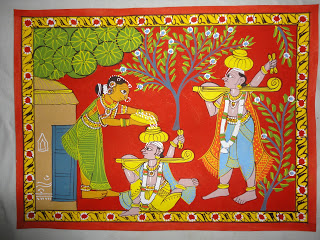
“Depicting one scene in the small scrolls cost about Rs. 500, but the price increases with greater intricacy. For storytellers, the price is quoted per metre of work.“[4]
For a small investment, the livelihood of the traditional preservers of an organic art can be secured. Stories are told not only by cinema or podcast, but by the arts and the crafts. The heritage of a people is based not only in museums and art galleries, but also in the villages and huts of rural India. It is here that the beating heart of the people and their popular culture is protected and passed on for the next generation.
https://youtu.be/vrBLpqUUziA
References:
- http://www.craftscouncilofindia.org/craft-process/hand-painting/
- http://cheriyalpaintings.blogspot.com/2016_01_01_archive.html
- http://www.thehindu.com/arts/crafts/scrolls-of-stories/article4098074.ece
- http://www.thehindu.com/features/friday-review/art/curator-of-a-tradition/article5138515.ece
- http://www.warangalonline.in/city-guide/cheriyal-scroll-paintings
- http://www.thehindu.com/thehindu/mp/2004/05/20/stories/2004052001190300.htm
- http://cheriyalpaintings.blogspot.com/2014_07_01_archive.html
- http://www.thehindu.com/todays-paper/tp-features/tp-fridayreview/cheriyal-the-pride-of-telangana/article6596306.ece
- http://lepakshihandicrafts.gov.in/cherialscrollpainting.html#
